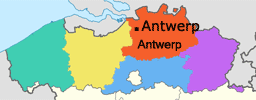 Peter Paul Rubens arguably is the most famous Flemish painter. Born in 1577 in Germany from Flemish parents, he moved to Antwerp with his mother in 1589.
During his youth he studied Latin and classic literature, and painting under Antwerp's leading painters of the time. Peter Paul Rubens arguably is the most famous Flemish painter. Born in 1577 in Germany from Flemish parents, he moved to Antwerp with his mother in 1589.
During his youth he studied Latin and classic literature, and painting under Antwerp's leading painters of the time.
During early adulthood Rubens travelled to Italy where the studied and became influenced by the Italian masters of the time.
In 1609 he came back to Antwerp. At the time Antwerp started to prosper again, with a recent truce established in the armed conflicts between Habsburg Spain (occupying the Southern Netherlands or present day Flanders) and the Dutch Republic to the north.
 |
Self-portrait by Peter Paul Rubens - Rubenshuis Museum, Antwerp.
|
|
Rubens moved into a new house with studio that he designed himself. This house is now known as the Rubenshuis Museum, off the main shopping street of Antwerp (the Meir), and located in the Wapper street. Rubens had many apprentices, working in his studio, including the young Anthony Van Dyck.
It is during that time, that the two altarpieces now in the Cathedral of our Lady in Antwerp, were produced.
Interesting is that Rubens made good use of the distribution facilities of the time, by producing many prints of his works, for distribution in Europe. He even established copyrights for his prints.
Rubens left Antwerp again in 1621, living in France, England and Spain. He was also active as a diplomat, entrusted by the Spanish Habsburg rulers with diplomatic missions.
As a result op these travels, a lot of the paintings of this period are now in various European museums.
However, the Assumption of the Virgin Mary (1625-1626) was painted for the Cathedral of Antwerp.
Rubens eventually came back to Antwerp in the last decade of his life (1630-1640), and in 1630 at age 53, he married his second wife, the 16-year old Helene Fourment, who reportedly became one of his most favoured models during the latter days of his life.
Peter Paul Rubens was a prolific artist. He also co-produced lots of art work with his apprentices and fellow painters. On top of that, he was an active art designer. His paintings are now famed for the depiction of voluptuous women, so much so that the term 'Rubenesque' is to this day used for somewhat over-sized females. To be sure, also the males in many of his religious paintings, are oversized, and not exactly by an abundance of muscles.
Last time I checked, a painting of Rubens, 'Massacre of the Innocents', still holds the record as the most expensive painting by an old master, sold at auction (Sotheby's, 49.5 million Pounds). (Nowadays, a lot of more recent work, goes for higher prices).
Rubens in Antwerp :
1. Cathedral of Our Lady (Onze-Lieve-Vrouwekathedraal) : The Raising of the Cross (1610-1611) The Descent of the Cross (1612-1614) Assumption of the Virgin Mary (1626)
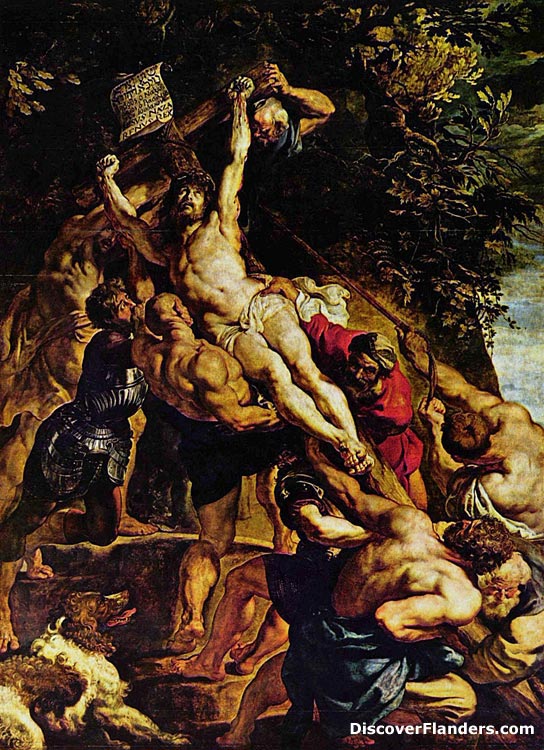 |
Raising of the Cross, by Peter Paul Rubens, Cathedral of Our Lady, Antwerp. |
|
2. Rubenshuis Museum : The Annunciation Adam and Eve (circa 1600), Self portrait (at about age 50)
3. Charles Borromeo's Church Originally the Charles Borromeo's Church contained : The Miracles of St Ignatius Loyola (1617), now in Vienna, Kunsthistorisches Museum The Miracles of St. Francis Xavier (1617-1618), now in Vienna, Kunsthistorisches Museum The Charles Borromeo's Church was built at the time when Rubens was residing in Antwerp. The ceiling of the Church had no less than 39 paintings by Rubens (and coworkers). They were all destroyed in a fire in 1718. However about half of the design sketches have been preserved and are in various art collections around the world. The sumptuous decoration on the facade is also partly attributable to Peter Paul Rubens.
4. Saint James' Church
Peter Paul Rubens is a bit omnipresent in Antwerp, but it is here that you will find the chapel of the family of the famous Baroque painter, Our Lady's Chapel.
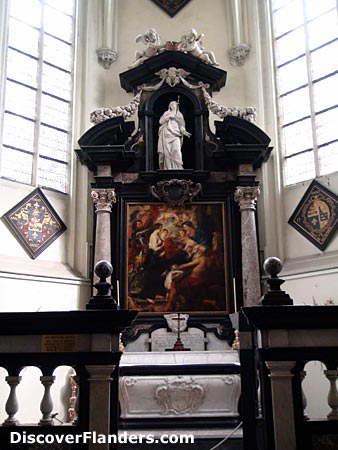 |
Our Lady Chapel, with the tomb of Peter Paul Rubens, at Saint James' Church, Antwerp..
|
|
5. Royal Museum of Fine Arts Antwerp (KMSKA) : The Royal Museum of Fine Arts has a Rubens Room, dedicated to a large collection of works by the painter. Works include : Adoration of the Magi (1624), one of many versions of this work. Holy Virgin surrounded by Saints (1628) Christ on the Straw (1618) The Baptism of Christ (1604-1605). The Royal Museum of Fine Arts Antwerp has reopened recently after a very long period of renovation.
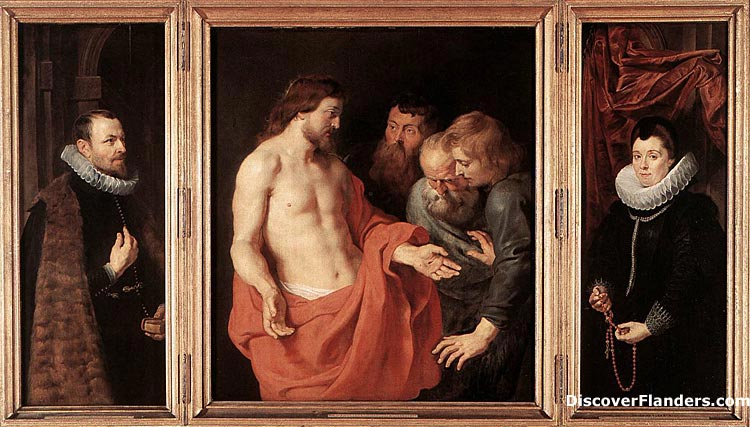
|
The Incredulity of Saint Thomas by Peter Paul Rubens - Koninklijk Museum voor Schone Kunsten
(Royal Museum of Fine Arts), Antwerp
|
For example, eight altar pieces from the Museum were exhibited (Reunion. From Quinten Metsijs to Peter Paul Rubens. Masterpieces from the Royal Museum reunited in the Cathedral) till 2017 in the Cathedral of Our Lady, which made it even more imperative to visit Antwerp's cathedral. Originally, these works belonged to the cathedral, but were dispersed at the time of the French revolution with subsequent occupation of Belgium.
Admission to the Cathedral of Our Lady : 5 Euro.
Opening Hours :
Mo-fr 10am - 5pm
Sa 10am - 3pm
Su 1pm - 4pm
Virtual Rubens' Room of Museum
Rubenshuis Museum
Rubens bought the house that now carries his name in 1610, when he started spending a lot of time in Antwerp. The Rubenshuis is located off the popular shopping high-street, the Meir. The house was constructed initially combining Greco-Roman classicism and Italian Renaissance art. Its present address is at Hopland 13 2000 Antwerp.
The house was eventually sold by Rubens's heirs in 1660. It was acquired by the city of Antwerp in 1937. Later on, after renovation, the former residence of Rubens was opened as a museum. In reality, only the porch and the garden pavilion belong to the original residence.
The Rubenshuis houses a collection of paintings, some by Rubens himself, some by his contemporaries and apprentices. The paintings are displayed throughout the house.
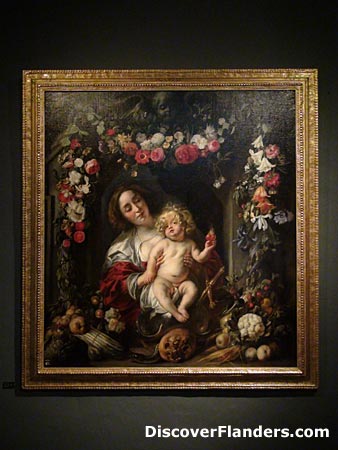 |
Virgin and Child in a Garland of Flowers, Fruits and Vegetables. By Jacob Jordaens, Rubenshuis, Antwerp.
|
|
There are about 2,500 of them, impossible of course for one man alone to handle. But Rubens was as much a designer as a painter, and a lot of the actual painting works was done by apprentices, employees, contemporaries in his studio.
The museum contains the paintings 'The Annunciation' and 'Adam and Eve' by Peter Paul Rubens. All the paintings and art works are numbered.
Entry prices to the Rubenshuis are 12 Euros for adults, 8 Euro for people aged 18-25 years. Younger people have free access. The opening hours are : Mon-Tue, Thu-Fri: from 10 am to 5 pm, Sat-Sun: from 10 am to 6 pm. Closed on Wednesdays.
Images and content copyrighted G.V.
|